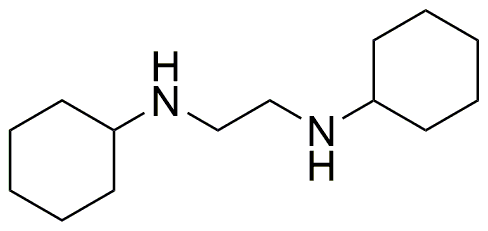N,N'-Dicyclohexyl-1,2-ethanediamine is widely utilized in research focused on:
- Catalysis: This compound serves as an effective ligand in various catalytic processes, enhancing reaction rates and selectivity in organic synthesis.
- Polymer Chemistry: It is used as a curing agent in epoxy resins, providing improved mechanical properties and thermal stability in coatings and adhesives.
- Pharmaceutical Development: The compound is explored as a potential intermediate in the synthesis of pharmaceutical agents, aiding in the development of new drugs.
- Material Science: Its unique properties make it suitable for creating specialized materials, such as elastomers and thermoplastics, which are used in automotive and consumer goods.
- Research Applications: In academic settings, it is often employed in studies related to coordination chemistry and molecular design, facilitating advancements in chemical research.
General Information
Properties
Safety and Regulations
Applications
N,N'-Dicyclohexyl-1,2-ethanediamine is widely utilized in research focused on:
- Catalysis: This compound serves as an effective ligand in various catalytic processes, enhancing reaction rates and selectivity in organic synthesis.
- Polymer Chemistry: It is used as a curing agent in epoxy resins, providing improved mechanical properties and thermal stability in coatings and adhesives.
- Pharmaceutical Development: The compound is explored as a potential intermediate in the synthesis of pharmaceutical agents, aiding in the development of new drugs.
- Material Science: Its unique properties make it suitable for creating specialized materials, such as elastomers and thermoplastics, which are used in automotive and consumer goods.
- Research Applications: In academic settings, it is often employed in studies related to coordination chemistry and molecular design, facilitating advancements in chemical research.
Documents
Safety Data Sheets (SDS)
The SDS provides comprehensive safety information on handling, storage, and disposal of the product.
Product Specification (PS)
The PS provides a comprehensive breakdown of the product’s properties, including chemical composition, physical state, purity, and storage requirements. It also details acceptable quality ranges and the product's intended applications.
Certificates of Analysis (COA)
Search for Certificates of Analysis (COA) by entering the products Lot Number. Lot and Batch Numbers can be found on a product’s label following the words ‘Lot’ or ‘Batch’.
*Catalog Number
*Lot Number
Certificates Of Origin (COO)
This COO confirms the country where the product was manufactured, and also details the materials and components used in it and whether it is derived from natural, synthetic, or other specific sources. This certificate may be required for customs, trade, and regulatory compliance.
*Catalog Number
*Lot Number
Safety Data Sheets (SDS)
The SDS provides comprehensive safety information on handling, storage, and disposal of the product.
DownloadProduct Specification (PS)
The PS provides a comprehensive breakdown of the product’s properties, including chemical composition, physical state, purity, and storage requirements. It also details acceptable quality ranges and the product's intended applications.
DownloadCertificates of Analysis (COA)
Search for Certificates of Analysis (COA) by entering the products Lot Number. Lot and Batch Numbers can be found on a product’s label following the words ‘Lot’ or ‘Batch’.
*Catalog Number
*Lot Number
Certificates Of Origin (COO)
This COO confirms the country where the product was manufactured, and also details the materials and components used in it and whether it is derived from natural, synthetic, or other specific sources. This certificate may be required for customs, trade, and regulatory compliance.


